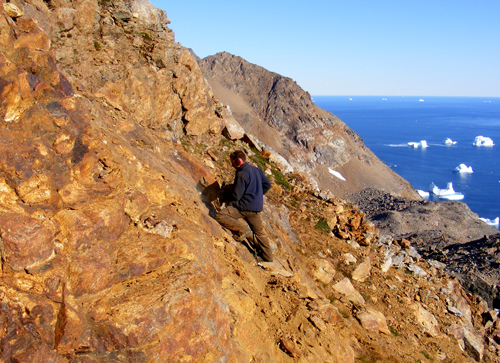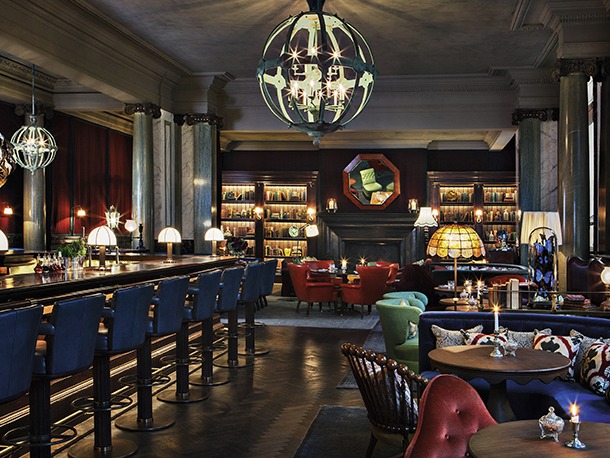
It was in 2009 that two senior geologists with the Greenlandic exploration company NunaMinerals decided that there was no question that Greenland was on the verge of transforming from a fisheries-based economy to a major player in key minerals. An exploration company, they reasoned, that really understood the regional geology as well as the most advanced technologies available would be urgently needed.
So Claus Oestergaard and his partner Anders Lie, both based in the 'mother country' Denmark decided to set up 21st North to really optimise mineral exploration, whether on its own behalf or for clients. In between the two of them, Oestergaard and Lie had more than 30 years' experience of working in all parts of Greenland, Oestergaard has also worked directly within GEUS, the Geological Survey of Denmark and Greenland, which has amassed almost all the available historical data on which more specific modern work has to rely.
Lie and Oestergaard were among the first in the exploration business to realise and apply the potential of digital satellite imagery In Greenland, as well as remote sensing capabilities, hand held XRFs and hyperspectral technologies which use different wavelengths to identify alteration features and rock types even before you go into the field. “Remote sensing is helpful because it is something you can do at home from your desk!” says Oestergaard. Applying 21st century techniques to develop resources gave the company its name, and today it has a well-established partnership with the British remote sensing, image processing, GIS and digital mapping services company HME Partnership.
Getting established was not that easy though, says Oestergaard: “We knew it was a tough place to start, which is why we included several extra legs to stand on, so we offer contract exploration services and consultancy to firms wanting to get involved in Greenland as well as developing our own licences.” However these properties, most of them owned through a subsidiary company Greenland Gold Resources, take up 75 percent of 21st North's energies. “Our core business is the exploration and development of projects,” he explains.
However it is quite a unique potential partner for anyone wanting to develop new grassroots exploration projects in under-explored regions of Greenland and Scandinavia. The way forward for this company will be via joint ventures says Oestergaard. “Whether our key projects will be listed at some point or remain private is an open question – but at some point we would welcome partnerships that allow us to conduct exploration projects on a more regional scale, supported by investors, with a focus, probably, on east or south Greenland. There are some really interesting regions in Greenland which require grass roots exploration but further development requires financing.”
21st North's most advanced project so far is its Akuliaruseq graphite deposit, between the towns of Sisimiut and Aasiaat on the west coast of Greenland and close to the airport at Kangerlussaq. Greenland has a long history of small scale graphite mining, he explains. Knowledge of the Akuliaruseq deposit goes back as far as 1912-1916 where sporadic mining took place. No further work was done until the 1980s, but by 1986 geological and geophysical exploration work had outlined and test drilled four favourable blocks defining an open-ended indicated resource of 5.34Mt grading 9.5 percent C. Bulk sampling indicated that a significant volume of the deposit consists of large and giant size graphite flakes without impurities, the most important criteria for flake graphite deposits.
The company has recently applied for extension of the property and will conduct a surface exploration programme this year to outline additional resources. In addition, a €1.85 million, 5,000 metre drilling campaign is proposed to establish the depth and extent of the Akuliaruseq deposit as well as further testing the flake size, leading to test mining in order to be certain that this is not just a large scale resource but also one that can be successfully exploited. “Though we are an exploration company and generally not interested in mine building or beneficiation as such, we always have an eye to these matters early on,” he says. Once it has done the preliminary work and taken the project up to feasibility or pre-feasibility stage, the company wants to attract partners who will buy in to the project and take it forward to production. At his point 21st North's interest will start to dilute or may be sold outright.
Less well known till 21st North came on the scene was the Ikertoq Prospect, a 151 square kilometre nickel-copper licence in the same general area of Greenland, strategically located 60 kilometres from the international airport in Greenland and eight kilometres from a deep water fjord. In partnership with Northern Shield Resources, a Canadian junior, 21st North will drill up to 2,000 metres this summer at a cost of €1,000.000. It could be a very exciting project. Greenland and Canada were once joined together and for years mining companies have been searching in Greenland for the continuation of Quebec’s Raglan Nickel Belt and the structure that hosts the Voisey’s Bay Nickel Deposit. The Ikertoq property could well be it.
Another nickel-copper deposit in the portfolio has already seen some test drilling, and more is to be carried out. Though its principal town Tasiilaq is easily accessible by sea and has daily flights to the west coast and Iceland, the island of Ammassalik off the south east coast of Greenland has seen limited exploration activities and early testing up to 2005 missed the best deposits. Now 21st North has exclusive mineral rights over an 84 square kilometre area that it considers has great potential for copper, nickel and platinum group elements (PGEs). There is also gold bearing rock in this region.
Titanium and vanadium are among the many metals that are in increasing demand round the world. They are present in a highly accessible surface deposit at Sinarsuk near Fiskenæsset just 125 miles south of the capital Nuuk – there's virtually no overburden at all so once 21st North has completed its validation of the site it should be very attractive to an investor.
Though GEUS has done a huge amount of work, and a sporadic amount of development and exploration has taken place in recent years, there are still many parts of Greenland that have only seen limited exploration activity but where there are a lot of interesting finds to be made, says Oestergaard. “We rely very much on that historic information to decide that any particular area might be interesting to go into and work on, in fact we have done that with most of our projects.”
Remote sensing technologies give excellent results in Greenland.. “Looking at reflections from different wavelengths over a wide spectrum gives you a great deal of geological information. Another wonderful thing about Greenland is that there are no trees and excellent exposure due to the historic glaciation. You can see a lot of information you can't in other parts of the world.”
The centre of Greenland, 83 percent of its surface area, is inaccessible because of the ice cover, but its uncovered part is larger than France, he points out. He prefers to work in the southern and central part of the country. Though there are great deposits in the north, he feels that investors are less likely to be captivated by projects that are hard to access from a logistical point of view, and more importantly whose production can only be shipped out for a few months of the year, Below the Arctic Circle, warmed by the Gulf Stream, pierced by numerous deep water fjords, the southern coasts are a miner's dream compared with many parts of the world.
And Greenland is one of the most secure and investment-friendly countries in the world, backed by Denmark though jealous of its independence and always vigilant on behalf of its population and its land and marine ecology. The biggest drawback is the lack of infrastructure, but this can be costed into any venture and may be offset by so many positive features that it becomes less significant. It does require deposits with good grade and tonnage to be economic, though. “When new companies start to consider Greenland they get anxious, naturally enough. That is why most of them quickly realise they need a local partner,” says Claus Oestergaard. “That is where we see ourselves. We give the companies the confidence that their investment is in safe hands. We know how to operate in all parts of Greenland with a sure hand!”
Written by John O'Hanlon, research by Richard Halfhide
DOWNLOAD
 21stNorth-Greenland-SPR-Bro-s.pdf
21stNorth-Greenland-SPR-Bro-s.pdf













